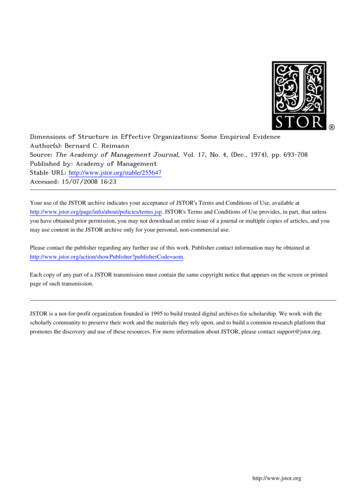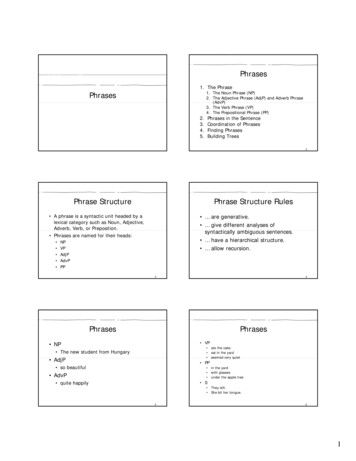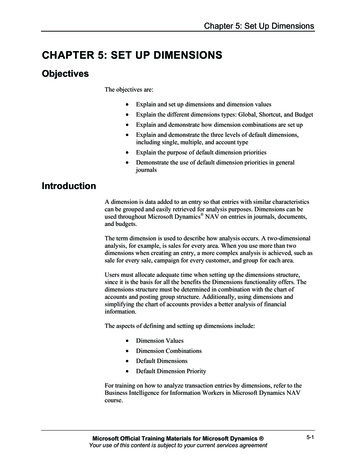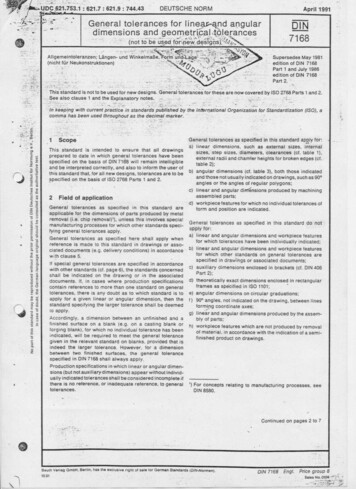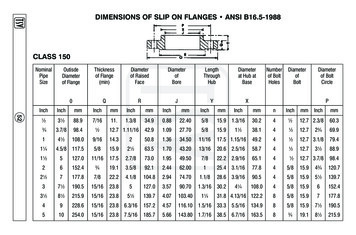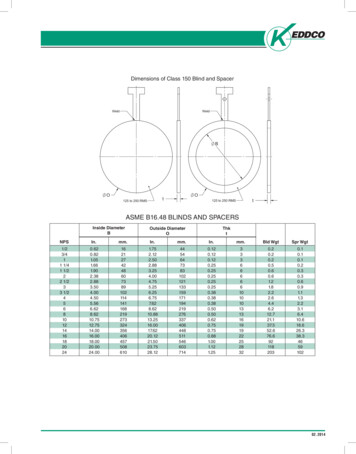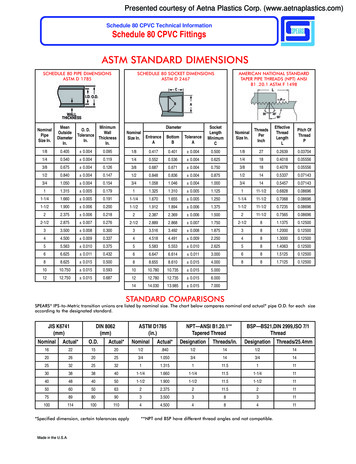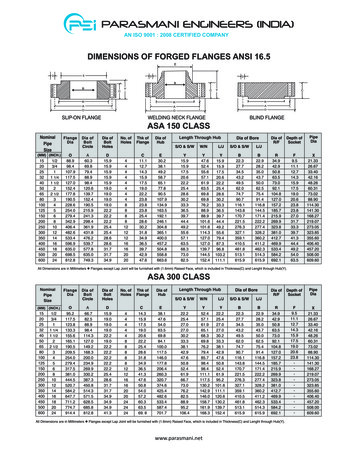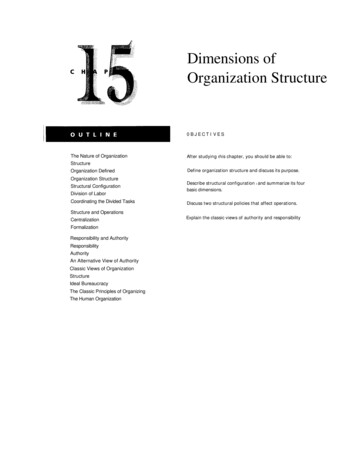
Transcription
Dimensions ofOrganization Structure0BJECTIVESThe Nature of OrganizationAfter studying this chapter, you should be able to:StructureOrganization DefinedOrganization StructureStructural ConfigurationDivision of LaborCoordinating the Divided TasksStructure and y and AuthorityResponsibilityAuthorityAn Alternative View of AuthorityClassic Views of OrganizationStructureIdeal BureaucracyThe Classic Principles of OrganizingThe Human OrganizationDefine organization structure and discuss its purpose.Describe structural configuration I and summarize its fourbasic dimensions.Discuss two structural policies that affect operations.Explain the classic views of authority and responsibility De scribe the classic views of organization structure.
The Signal Company started in the oil and gas business in1922 and merged with Garrett Corporation, the aircraftengine and equipment giant, in 1964. Allied Chemical &Dye Corporation, founded in 1920, moved into the oil andgas business with the purchase of Union Texas Natural Gasin 1962, into the aerospace business through the purchase ofthe Bendix Corporation in 1983, into electronics withEltra and Bunker Ramo, and into health and scientificproducts with Fisher Scientific. Finally, in 1985 the twocompanies merged to become Allied-Signal Incorporated,putting together Signal's Garrett division and Allied'sBendix division to make aerospace Allied-Signal's largestbusiness sector. It had a typical conglomerate structurewith the different businesses run somewhat independently,each with the typical functional organization structure.More change is coming, however, at Allied-Signal.In response to changes in information technology (thespeed with which information is manipulated, stored,retrieved, and disseminated) and the need for increases inproductivity, quality, service delivery, and job satisfaction,Allied-Signal is moving toward what they think will be theAllied Signal Incorporated, amulti-business conglomerate, hasrecently been reorganized. Insteadof a traditional departmental system,Allied-Signal employees are assignedto particular products and processes.Here, two workers inspect carpetsamples at Azko, a EuropeanCompany in wich Allied-Signal hasacquired a majority interest.way most organizations will be organized in the twenty-first century. Rather thanhave departments with the basic business functions of marketing, accounting, humanresources, engineering and others, Allied-Signal plans to organize around processes.Its chief executive officer, Lawrence A. Bossidy, predicts that there will be an organizational revolution. He expects that organizations will organize around the materialsand product flows rather than the traditional functions. The lack of departmentsin the new organization means that Allied-Signal will have no department of engineering, accounting, purchasing, or marketing. All employees have already gonethrough the company's training program on total quality management, whichBossidy expects will aid in changing employee attitudes and work behaviors.Most companies have several basic processes.- for example, new, product development,flow of materials, and order-delivery billing cycle. At Allied-Signal, specialists will beassigned to one of the basic processes and make their functional contributions to thatprocess. A marketing specialist may be involved in new product-development, from concept to design to actual manufacturing. A specialist in finance will be involved in eachprocess as needed. 7'hese specialists will be available to contribute their expertise to eachprocess. Engineers will know each other and be able to share information with each otherbut will not necessarily work with each other every day. Although the new structure maybe somewhat confusing at first, Allied-Signal expects the benefits to be worth itOrganizations such as Allied-Signal do not make major structural changesarbitrarily; rather, they must have some co mpelling reason. Allied-Signalwas already known as the industry leader in aerospace and automotive prod1. "The Search for the Organization of Tomorrow," Fortune, May 18, 1992, pp. 92-98; Thomas A. Stewart, "AlliedSignal's Turnaround Blitz," Fortune, November 30, 1992, pp. 72-77; and Gary Hoover, Alta Campbell, and PatrickJ. Spain, Hoover's Handbook of American Business 1993 (Austin, Tex.: The Reference Press, 1992), p. 99.
ucts, electronics, and health and scientific products, but its managers believed thatreorganizing would help focus the company's efforts to serve customers better. In thischapter, we explore how the structure of an organization can be a major facto, in howsuccessfully the organization achieves its goals. We begin with an overview oforganizations and organization structure that defines each and puts organization structurein the context of organizational goals and strategy. Second, we dis. cuss the two majorperspectives of organizing, the structural configuration view and the operational view.Then, we discuss the often confusing concepts 0: responsibility and authority and presentan alternative view of authority Finally we show several of the classic views of howorganizations should be structuredThe Nature of Organization StructureIn Parts 1 through 4 we discussed major elements of the individual and the factor, thattie the individual and the organization together. In a given organization, these factorsmust fit together within a common framework: the organization's structure,An organization is a group ofpeople working together toattain common goals.Organizational goals areobjectives that managementseeks to achieve in pursuingthe firm's purpose.Organizational goals keep theorganization on track by focusingthe attention and actions of itsmembers.Organization structure is asystem of task, reporting, andauthority relationships withinwhich the organization does itswork.An organization is a group of people working together to achieve common goals. Topmanagement determines the direction of the organization by defining its purpose,establishing the goals to meet that purpose, and formulating strategies to achieve thegoals.The definition of purpose is the organization's reason to exist; in effect, it answers thequestion, "What business are we in?" The establishment of goals converts the definedpurpose into specific, measurable performance targets. Organizational goals areobjectives that management seeks to achieve in pursuing the purpose of the firm. Goalsmotivate people to work together. Although each individual's goals are important to theorganization, the organization's overall goals are the most important. Goals keep theorganization on track by focusing the attention and actions of the members. They alsoprovide the organization with a forward-looking orientation. They do not address pastsuccess or failure; rather. they force members to think about and plan for the future.Finally, strategies are specific action plans that enable the organization to achieve its goalsand thus its purpose. They involve the development of an organization structure and theprocesses to do the organization's work.Organization structure is a system of task, reporting, and authority relationships withinwhich the work of the organization is done. Thus, structure defines the form and functionof the organization's activities. Structure also defines how the parts of an organization fittogether, as in an organization chart.2. See Richard Daft, Organization Theory and Design, 2nd ed. (St. Paul, Minn.: West, 1986), p. 9, for ftirther discussion ofthedefinition of organization.3. John K Montanari, Cyril r. Morgan, and Jeffrey S. Bracket, Strategic Management (Hinsdale, Ill.: Dryden Press 1990),pp. 1-2.Part 5Organizational Processes and Characteristics
The purpose of organization structure is to order and coordinate the actions ofemployees to achieve organizational goals. The premise of organized effort is thatpeople can accomplish more by working together than they can separately. If thepotential gains of collective effort are to be realized, however, the work must becoordinated. Suppose that the thousands of employees at Ford Motor Co. workedwithout any kind of structure. Each person might try to build a car that he or shethought would sell. No two automobiles would be alike, and each would takemonths or years to build. The costs of making the cars would be so high that noone would be able to afford them. To produce automobiles that are both competitive in the marketplace and profitable for the company, Ford must have a structure in which its employees and managers work together in a coordinated manner.The task of coordinating the activities of thousands of workers to produce carsthat are not only drivable but guaranteed for 60,000 miles may seem monumental. Yet whether for mass producing cars or making soap, the requirements oforganization structure are similar. First, the structure must identify the tasks orprocesses that must be p erformed for the organization to reach its goals. This isoften called division of labor. Even small organizations (those with fewer than onehundred employees) use division of labor. Second, the structure must combineand coordinate the divided tasks to achieve a desired level of output. The moreinterdependent the divided tasks, the more coordination is required. Every organization structure addresses these two fundamental requirements. The various waysthat they do so are what make one organization structure different from another.Organization structure can be analyzed in three ways. First, we can examine itsconfiguration, or its size and shape as depicted on an organization chart. Second,we can analyze its operational aspects or characteristics, such as separation of specialized tasks, rules and procedures, and decision making. Finally, we can examineresponsibility and authority within the organization. In this chapter, we look atorganization structure from all three points of view.The structure of an organization is most often described in terms of its organizaAn organization chart is ation chart. A complete organization chart shows all people, positions, reportingdiagram showing all people, relationships, and lines of formal communication in the organization. (As we dis positions, reportingcuss in Chapter 14, however, communication is not limited to these formal chanrelationships, and lines ofnels.) Large organizations may need several charts to show all positions. Forformal communication inexample, one chart may show top management, including the board of directors,the organization.the chief executive officer, the president, all vice presidents, and important headquarter staff units. Subsequent charts may show the structure of each departmentand staff unit. Figure 15.1 shows two organization charts for a large firm; theupper portion of the figure shows top management and the lower portion showsthe manufacturing department. Notice that the structure of the different manufacturing groups is given in separate charts.4. A. BryMan, A. D. Beardsworth, E. T. Keil, and J. Ford, "Organizational Size and Specialization," OrganizationStudies, September 1983, pp. 271-278.5. Joseph L. C. Cheng, "Interdependence and Coordination in Organizations: A Role System Analysis," Academy ofManagement journal, March 1983, pp. 156-162.6. See Henry Mintzberg, The Structuring of organizations (Englewood Cliffs, N.J.: Prentice-Hall, 1979), for furtherdiscussion of the basic elements of structure.Chapter ISDimensions of Organization Structure
Top Management ChartExamples ofOrganization ChartsConfiguration is the shape ofthe organization, made up ofdivision of labor and the meansof coordinating the dividedtasks.An organization chart depicts reporting relationships and work group memberships andshows how positions and small work groups are combined into departments, whichtogether make up the configuration, or shape, of the organization The configuration oforganizations can be analyzed in terms of how the two basic requirements ofstructure-division of labor and coordination of the divided tasks are fulfilled.Division of laborDivision of labor is theextent to which the organization's work is divided intodifferent jobs to be done bydifferent people.Division of labor is the extent to which the organization's work is separated intdifferent jobs to be done by different people. Division of labor is one of the severprimary characteristics of structuring described by Max Weber 7 but the concept7. Max Weber, 7he theory of Social and Economic Organization, trans. A. M. Henderson and Talcort Parsoii!(New York: Free Press, 1947).Part 5Organizational Processes and Characteristic
can be traced back to the eighteenth-century economist Adam Smith. As we noted in Chapter1, Smith used a study of pin making to promote the idea of dividing production work toincrease productivity. Division of labor continued to increase in popularity as largeorganizations became more prevalent in a manufacturing society. This has continued, andmost research indicates that large organizations usually have more division of labor than smallones.9Division of labor has also been found to have both advantages and disadvantages (seeTable 15.1). Modern managers and organization theorists are still struggling with the primarydisadvantage: division of labor often results in repetitive, boring jobs that, undercut workersatisfaction, involvement, and commitment." In addition, extreme division of labor may beincompatible with new, integrated computerized manufacturing technologies that requireteams of highly skilled workers.Division of labor, however, need not result in boredom. Visualized in terms of a smallorganization such as a basketball team, it can be quite dynamic. A basketball team consists offive players, each of whom plays a different role on the team. In professional basketball thefive positions typically are center, power forward, small forward, shooting guard
An organization chart is a tion chart. A complete organization chart shows all people, positions, reporting diagram showing all people, relationships, and lines of form al communication in the organization. (As we dis - positions, reporting cuss in Chapter 14, however, communication is not limited to these formal chan -
